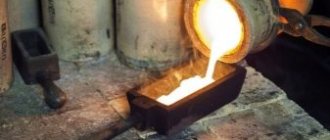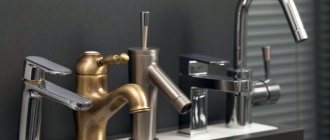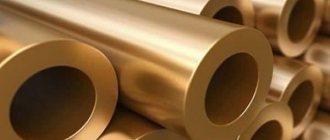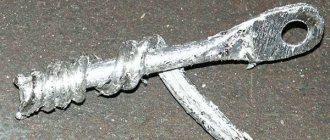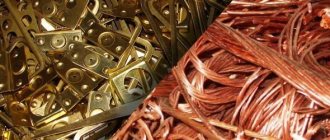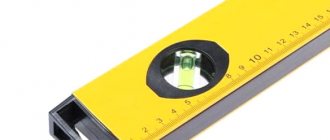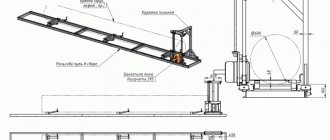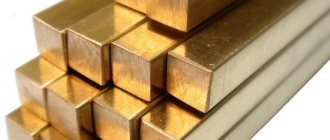Faucets are used both in the bathroom and in the kitchen. But not all of them are of good quality. No one should look at the beautiful and attractive design, one must first understand what material was used to make these devices. The most common materials are brass and silumin. Not everyone knows how to distinguish a brass faucet from a silumin one and what the difference is between them. Meanwhile, the durability and quality of work of such products depends on this.
Knowledge on the topic is the key to success
In order to avoid making mistakes when buying a mixer, you need to be not only careful, but also prudent. Nowadays you can find a lot of sanitary ware products from China on sale, which are not of good quality. It is very important to understand in advance how to distinguish a silumin faucet from a brass one, because it is unlikely to be found by appearance. Not all buyers are specialists who are well versed in this issue. And what aspects should you focus on here if you don’t have any special knowledge?
In fact, to understand how to find a brass or silumin faucet, there is no need to graduate from a university or attend any courses. Even someone who has never purchased such products will be able to figure this out. Here, only vigilance and some knowledge of what is best from the proposed materials will be useful. And the second thing, without which it will not be possible to correctly create a choice, is vigilance. Every little detail must be taken into account to prevent an irreparable mistake.
Silumin or brass: which is better?
Any material has its own individuality, so you can note both certain advantages and disadvantages. What is a definite advantage of silumin? Here two main properties can be distinguished - the most applicable cost and ease. Therefore, we can say that it is unsurpassed for creating economical plumbing fixtures. But at the same time, its property will not be very high. If we take into account what is stronger brass will be the most reliable .
You can highlight several main shortcomings of silumin, then everything will become clear which faucet for the bathroom or kitchen is better to choose.
- It does not withstand maintenance, so even with minor repairs it can quickly break down.
- Most often, floods in apartments occur due to the breakdown of situmin faucets.
- They often try to pass off silumin as brass, which is in favor of the second option.
- Poorly withstands high pressure.
The last point is very important, because silumin mixers can withstand pressure only up to 3 bar. But in new buildings, and also in the evening, the pressure in the water supply can rise to 10 bar.
The right choice of mixer
Now it’s worth figuring out how to distinguish brass from silumin, what should you pay attention to? Here you need to look at the following points:
- price;
- weight;
- surface of the material.
But all these are relative characteristics, because the Chinese began to add heavy alloys to silumin, so it is not always possible to distinguish a silumin mixer from a brass one by weight. You need to make sure that the technical properties indicate the letter “L” and not “AL” .
Silumin mixers are constantly cheaper. They are made by stamping. To understand how to distinguish brass from silumin in a mixer, you need to look at the material itself. Do not forget that brass faucets are manufactured only by casting , so you don’t have to worry about their properties.
Our company produces only reliable mixers. We try to deal with dealers who purchase plumbing fixtures in bulk. It is profitable to cooperate with us because we are manufacturers of such sanitary products. You can immediately purchase various components. According to evidence of properties, our brass faucets are no different from any Euro brand, but their cost is significantly lower.
Interesting read: How to bend a brass tube at home
Individuality of brass faucets
This material is a mixture of copper and zinc alloy, while the latter gives the best workability, which is why the faucet costs even less than its counterpart made of pure copper. In addition, it gives brass increased corrosion resistance and the ability to withstand sudden temperature changes, so such faucets can serve smoothly for a long period of time without losing their operational parameters.
At first, brass has a light golden color (which is why it is used in the jewelry industry), but taps are almost always coated with another material: nickel, bronze or brass, with the latter being the most common. A shiny surface has a mirror-like shine, but stains and fingerprints remain on it, so it requires more frequent cleaning than a matte surface. She owns nickel-plated faucets.
There are also taps with a coating that is similar to bronze. The corresponding brown color is assigned to it by the epoxy resins contained in the composition. This option is even better and more reliable than products made from unblemished bronze.
There are also elite gold-plated or silver-plated models that will look chic in rich interiors.
Brass faucets are highly durable, easy to repair (and European manufacturers of plumbing fixtures usually use similar sizes) and durable (their service life reaches 5 years or longer), but they also have shortcomings. For example, they are not very resistant to scratches and chips, but this does not affect their performance properties.
If you purchase a brass faucet without a surface coating, keep in mind that over time it will develop a green coating, which, in general, can simply be removed with the means at hand. In addition, the cost of brass taps is often very high.
At the moment, a trend has emerged among interior designers - multi-colored faucets. They are given the desired color or pattern using powder coating.
Brass taps are used completely everywhere: in apartments and public places, in kitchens and bathrooms. Depending on the design and coating, they can fit into any interior style: from classic to modern.
From time to time, manufacturers, wanting to save money, make brass faucet handles from plastic. This is an unreliable option and should be very avoided.
Kinds
The classification of brass faucets can be based on different characteristics. We should start with the types of brass that are used to create the plumbing fixtures that interest us.
- Simple brass or two-component brass is a combination of copper and zinc in different proportions. The percentage of zinc varies between 5-45%. As this indicator increases, the cost of the alloy decreases. If the zinc content in the alloy does not exceed 15%, then this material is called red brass. In yellow brass, the zinc content is in the range of 15-45%. This option is the most widespread. Two-component compositions are characterized by markings in the form of the letter “L” and a digital designation by which the amount of zinc can be determined.
- Multicomponent compositions, in addition to zinc and copper, include additional elements that act as alloying. There are a lot of options, from aluminum to lead.
The coating can now be created from a variety of materials. Not all of them are worthy of attention and deserve respect, but there are some really interesting examples:
- galvanic coating can be created from nickel, bronze, chromium, copper, which expands the range of brass faucets and improves their performance characteristics;
- silver and gold are rarely used to cover brass products, but such specimens can still be found in specialized stores;
- colored faucets coated with powder or enamel are increasingly found in stores, attracting consumers with high aesthetic characteristics, making them forget about reduced performance parameters.
The design can also be very different.
- Bathroom faucets can be equipped with a long or short spout and shower at the same time, or with just one of these additions.
- Two-valve models are recognizable by the presence of a pair of rotary taps - this was and remains the most reliable option.
- Single-lever models are equipped with one lift-and-swivel type lever, which is equally convenient for showers and conventional faucets. Such options are inferior in reliability to two-valve mixers, but they are also more convenient and easier to use.
- Contactless models have appeared relatively recently. They are equipped with valves that can be controlled using sensors. High cost and complex maintenance prevent them from gaining high popularity.
There are several varieties based on the method and location of installation.
- Wall models.
- Faucets installed on the side of the bathtub.
- Built-in faucets look presentable, but their high cost, complex installation and problematic maintenance are frightening.
- Floor elements are a new phenomenon, which is still perceived as exotic. These faucets are installed on a stand fixed to the floor. This design would be appropriate for large rooms where the bathtub is not close to the wall.
Properties of silumin mixers
This material consists of approximately 90% aluminum and 10-15% silicon (or, in the most complex alloys, contains the remaining alloying elements). It was invented in the 20th century and used in aircraft production, also in shipbuilding and the cosmic sphere of industrial activity. Plumbing fixtures began to be made from it relatively recently.
Currently, silumin accounts for about 55% of the plumbing fixtures market.
Thanks to the properties of silumin, the crane is characterized by lightness, wear resistance and corrosion resistance. In addition, it is distinguished by its plasticity and ease of processing, which is why there are a large number of design solutions for such products. On the plumbing market you can find silumin faucets to suit every taste.
But they have some disadvantages, which are more significant than their advantages. This is a very short service life, which takes no more than a year and a half. After this, users of such mixers complain about leaks and breakdowns, and repairs in this case do not help: when replacing the gasket or sealing cracks, the leak appears in another place after a short time. Therefore, only a complete replacement of the device will be cheaper and more effective.
Interesting read: Brass soldering iron tip
In addition, faucets made of silumin very quickly lose their presentation, becoming covered with scratches and abrasions. The inside of the faucet quickly becomes covered with limescale, which can lead to blockage.
Also, silumin mixers are indescribably fragile: they can almost be broken by hand.
The question may arise - why is such plumbing needed? Typically, faucets made of silumin are purchased for dachas, since they are not used there as often as in houses, and therefore they last longer. With all this, they usually have the lowest cost of all materials.
For the same reason, they are obtained for temporary housing.
Entertaining metallurgy
Science and industry go hand in hand. New scientific achievements are designed to improve the quality of life, including reducing the cost of production not only as a process, but also the product itself. At the same time, quality often suffers, as happened with silumin in consumer goods.
Silumin is an alloy of aluminum, silicon and various metal additives in small quantities. Developed in the 20th century. It retained its light weight and ease of processing, but became stronger than aluminum, although softer than duralumin (used in the aviation industry). It is used for the manufacture of boat motors and other products where strength and lightness are important.
Brass is an alloy of copper and zinc, known even before our era. Its main properties are corrosion resistance and strength. Since ancient times, it has been used to create weapons and jewelry (fake gold).
Since the beginning of the construction of production machines, including steam ones, brass has become an integral material for mechanisms.
Gears were made from it, including those that took on a large load. Now it is used in the production of gas turbines, chemical equipment, and equipment for the food industry. Nuts and fittings made from this material are used in various industries, in construction and in everyday life.
It seems like good materials, but what's the catch? Let's look at it one by one.
How to distinguish brass from silumin
On the outside, they are in no way different from each other - both can have either a shiny or matte surface, and also a very different design. But there are some details.
Before all that, it's the cost. For a silumin mixer it will always be lower than for a brass one. So you will have to pay more for durability, but in this case the benefit is 100% payback.
Another aspect is weight. Silumin is lighter. But this was the case until recently; now manufacturers have learned to add heavy alloys to it in order to pass it off as a different material.
Be sure to inspect the technical documentation of the product: it must be marked “Al”. If you see the letter “L”, then most likely you are dealing with silumin.
As already stated, this point does not matter when your main goal is to save. If a long service life is important to you, brass is the leader by a wide margin.
So we figured out how these materials differ from each other, and which one is better in various aspects. But which of these is more important is up to you to decide for yourself.
Design and colors
Plumbing products play no less a role in interior design than household appliances. The mixer should ideally fit the sink not only in size, but also in design, so it is better to buy equipment together and from the same series.
When choosing a kitchen faucet, interior designers recommend using the following rules. For a high-tech style, you should choose a laconic single-lever device of a simple shape coated with chrome. A good choice would be a faucet with a thermostat. For interiors in retro and Provence style, the best solution would be to choose a two-valve faucet made in gold, copper or bronze. In a Scandinavian-style kitchen, a stainless steel or stone-effect faucet will look great.
When choosing the color of the device, you should not only focus on the color of the sink, but also take into account additional factors. Both the overall color line of the set and some specific aspects matter, for example, the shade of handles on cabinets and drawers, the design of the kitchen apron, and the presence of decorative elements. For a square sink, an L-shaped faucet is better suited; for a round and oval sink, a device with a round spout is better suited.
Silumin and brass faucets: which material to choose
Silumin and brass are the main materials from which faucets are made. There are a huge number of enthusiastic reviews about silumin mixers, and there are no less fans of brass devices.
Finally
As for the price of mixers, it varies from 1,000 to 60,000 rubles. The differences depend on the material the faucet is made from and where you purchase it from. In dubious places you will buy a “branded” mixer for 1000-2000 rubles, but no one will give you a guarantee of operation. It is better to contact specialized stores when purchasing such things.
- You will find good reviews about expensive German (Hansa, Grohe), Italian (Fari, Fiori), Polish (Ferro), Czech (Imprese) faucets.
- From the middle price category, Emivi (Italy), Vidima (Bulgaria) and Mixxen (Spain-China) are praised.
- Among the budget (cheap) options, pay attention to the mixers Rossinka (Russia-China), Santekhpribor (Russia), Ukrsanlit (Ukraine).
When replacing plumbing fixtures in the bathroom or kitchen, problems arise in choosing faucets. Today the range and price range is very wide. In large chain stores you can find a mixer for 300 rubles, and in front of it there may be a similar one in appearance, but for 5,000 rubles. The buyer has questions about the difference between the two. This article was created to answer several of these questions.
What is silumin
Silumin is an alloy of aluminum and silicon. The composition may contain impurities of copper, titanium, magnesium and manganese, which are added specifically. The presence of iron, calcium, zinc indicates insufficient purification of the substance. It is not uncommon for sodium or lithium to be present.
Aluminum is the base of the alloy: its content is about 90%. This explains the external and high-quality similarity between aluminum and silumin. Both alloys are grayish, silvery when cut, and have a low density. Like aluminum, silumin is not afraid of corrosion due to a protective film of oxide compounds.
The physical characteristics of silumin depend on the second component. Silicon makes it strong and wear-resistant. The material can withstand enormous overloads, but up to a certain point. After passing the strength threshold, silumin becomes brittle and brittle.
Aluminum-silicon compounds have a low melting point - about 670 °C. Because of this, the cost of the alloy is lower than that of other iron substances.
You might be curious
Silumin mixers
Products made from an aluminum alloy with silicon are economy-class plumbing fixtures.
Silumin mixers have the following advantages:
- Strength;
- Corrosion resistance;
- Wear resistance;
- Little weight;
- Low cost.
But these advantages give way to serious shortcomings, the main of which is fragility. Temperature changes, pressure changes, careless installation and other reasons can render the faucet unusable within a few months.
Silumin faucets cannot be repaired. Even if you managed to select a gasket and pack the cracked product tightly, it will soon leak in another place.
Interesting read: Patination of brass at home
Alloy groups
Silumin alloys are divided into several groups. This distinction is made according to the purpose of the materials:
- AK 12 is a eutectic silumin containing 12% silicon. During heat treatment, the casting is not strengthened and does not become hard during shrinkage. Parts made of such material are structurally designed for sealed low-load devices.
- Highly alloyed hypereutectic silumin is labeled, for example, AK4M5. Belongs to the piston group and is used when performing work under high-temperature conditions. It has high resistance to high temperatures and wear resistance. The use of this alloy for particularly important products operating under high load conditions. These are large-sized and critical parts.
What is brass
This is an alloy based on copper and zinc. The amount of additional component does not exceed 30%. Zinc is cheaper than copper, and therefore the higher the content of the former, the lower the cost of the material. But such a solution worsens the properties of the finished alloy.
Let's look at how additives affect the characteristics. The brass composition is diluted:
- Nickel (increases strength and corrosion resistance);
- Tin (solves the problem of rust in salt water);
- Silicon (increases anti-friction properties, but reduces hardness and strength);
- Lead (simplifies processing, reduces strength);
- Manganese (anti-corrosion component that improves mechanical properties, the effect is further enhanced by tin, aluminum, iron).
Brass alloy is the most needed in the world. Due to the highest characteristics of strength and wear resistance, it is called the “endless alloy”. The material does not rust and is not subject to the brutal action of external causes.
The melting point reaches 950 °C. For this reason, also because of the high price of copper, creating an alloy is more expensive than producing silumin. They reduce the cost by increasing the zinc content. Changing the proportion simplifies the manufacturing technology of the alloy, but with a zinc content of 20% or more, brass cracks in a humidified environment.
You might be curious
Answers from experts
gorynych:
brass... made of brass, and nickel-plated and chrome-plated can be made of steel... and rust from the inside
yang bon:
There is no difference between brass and nickel! but there is silumin nekel but rarely, still a thin-walled one. brass fitting not ok. the most OK CAST IRON fitting!!!!
Alexander:
Often, brass of non-plumbing grades is hidden under the coating, which a professional could notice by oxidation of the surface
Leon Melesh:
the term/concept of fitting is very vague. For example, a subway tunnel is assembled from fittings weighing approximately 100 kg
Vyachesl@v:
Take brass.
Loyso:
1. Brass fittings are fittings made of Brass2. Nickel-plated fittings are fittings made from almost any material that are coated with an alloy of chromium or nickel for corrosion protection or for aesthetic purposes. again, it all depends on the thickness of the layer and the reasons for chrome plating.
I usually look at unfamiliar fittings by weight. Silumin is a very fragile and light material, I usually sift it out.
Dmitry:
Faucets are made from brass, less often from silumin and very rarely from bronze. I think I’ve also seen stainless brass, which is an alloy of copper and zinc. By the way, zinc leaches from brass over time (in some varieties). And some varieties also contain lead (which is why it is not used for drinking water). Bronze is a more expensive option. It is brighter new than brass. Over time it gives a greenish coating. (and figli is also a copper alloy). And you shouldn’t be afraid of copper - it is approved for drinking water and is very durable... And pink spots could be a reaction to bleach! I know of one swimming pool, with just chlorine: all the fittings there are just pink. And by the way, they periodically come to grief - they fall apart...
Andrey Ponomarev:
No, definitely not copper. Copper is a very soft metal, so brass is the best option for plumbing faucets. The fact that you see the appearance of colored spots (pinkish color) is possibly a thin layer of copper electroplating to improve adhesion to the next layer of paint material.
Irina Zasekina:
This is bronze (an alloy based on copper). Auxiliary metals can be nickel, zinc, tin, aluminum and other cheap additives.
TV networks Novocherkassk:
I think it's brass, the coating is just not of high quality. And the turntables are made of a different material, which is coated with copper so that the decorative coating holds well. Through copper plating, even plastic is coated with chromium.
Vladimir Petrov:
What difference does it make to you, the main thing is that it is heavy and of high quality. And then copper, brass, bronze, what difference does it make, everything is fine. Silumin wouldn't be superfluous
Elena:
To fill surface defects, a layer of copper is applied to the brass to fill unevenness, dents, scratches, and only then a layer of nickel and chromium or some other coating is applied
Timon:
This is a gold tap covered with copper for better adhesion to the galvanic coating)))) Saw Shura saw)))
Alexander Vakhromov:
Inspired by. I remembered how a plumber used a chisel to cut new taps before installation. I ask: - Why? Answers: I’ll install a new, shiny one - they’ll roll it up by evening! And with notches, who needs it?! Copper taps have sunk into oblivion. Your faucet is brass. Pink stains are the result of a chemical reaction, an aggressive component of detergents (most likely acid). The battery terminals also have pink spots.
Can't find a light?:
Brass is an alloy of copper and zinc, and when it is exposed to acid (solutions that have an acidic reaction), the acid and zinc interact - dezincification, so the pink color is brass devoid of zinc, i.e. pure copper. You can verify this at home by placing some brass part in a citric acid solution for some time.
Anatoly Bondar:
Most likely, it is a cheap zinc alloy, a copper substrate is electroplated, and a decorative bronze layer is placed on top. You will soon discover, underneath the copper coating, a gray alloy.
Brass faucets
Plumbing fixtures made of copper-zinc alloy belong to the luxury class. Brass faucets are valued for the following advantages:
- Strength and hardness;
- Wear resistance;
- Reliability and durability.
Copper-zinc products will last at least 5 years. Brass plumbing fixtures look impressive and are heavy. Thick cast walls and correct threaded connections minimize the possibility of leakage. Such plumbing can be repaired. The selection of parts is also simplified by the fact that European manufacturers of plumbing fixtures use similar standard sizes. At the same time, Chinese companies allow a difference of several mm.
A significant drawback of brass faucets is their high cost. But if you take into account the service life, the acquisition will be profitable.
Choosing a shower head
Popular materials are metal and plastic. Metal elements are durable and expensive. Plastic is cheaper, but has a shorter service life. It is easy to break if handled carelessly.
| TIP! Many cascade type faucets do not look like traditional faucets. They are disguised as a shelf on the wall, produced on a metal leg, in the form of a lamp, etc. |
Shower heads can have several modes of supply and spray of water flow. This can be jet, drip, or massaging irrigation. Type of installation of the element: manual, on the wall or ceiling. If you choose the manual option, you should purchase an additional holder. It will have to be mounted into the wall.
How to distinguish a silumin faucet from a brass one
Before all this, focus on cost. For a brass faucet it is an order of magnitude higher than for a silumin faucet. Aluminum-based products are often produced by Chinese manufacturers. It is difficult for a non-professional to find it by eye. Focus on weight - silumin products are light, as if they were plastic. But some manufacturers practice adding weights so that economical products pass for elite ones. Therefore, constantly inspect product documents.
This will allow you to avoid buying a bad brass faucet. Products with a huge zinc content in operation resemble silumin. A leak can form within a month. But only in this case it will appear faster not even on the thread, but on solid elements. In addition, the low copper content creates a risk of zinc leaching, which has a negative impact on the quality of tap water.
You might be curious
Price
As for the price of this material, it is quite low, about 80 rubles per 1 kg. alloy But the prices for goods made from this alloy are already an order of magnitude higher, but also quite inexpensive when compared with goods made from pure metal.
19.02.2020 911
go to sections
Items you may be interested in:
Bust of Pushkin A.S.
Ancient bust of Pushkin A.S. era of the USSR. Small item. Has obvious signs of time, scuffs, dents, scratches. This bust of Pushkin is... 1500 ₽
Bust of Gagarin Yu. A.
Bust of the first man in space - Yuri Alekseevich Gagarin. Yu.A. Gagarin - Soviet pilot-cosmonaut, hero of the Soviet Union, April 12, 1961... 0 ₽


